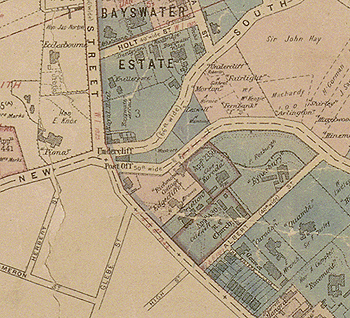The First Council Chambers
Securing a meeting place
One of the most pressing matters for the newly formed Woollahra Council was the need to find premises where it could hold regular meetings. At its second meeting held on 26 June 1860, the council resolved that a sub-committee consisting of Councillors Thompson and Gorman should investigate the securing of ‘the Iron House (Meymotts) for Council Chambers’. At council’s next meeting the councillors reported that ‘they had entered into an arrangement with Mr Nott and Mr Justice Wise for leasing Woodbine Cottage (the premises in which the Meeting were [sic] then assembled) as Council Chambers and Clerk and Surveyors residence, for two years, and [sic] a yearly rental of fifty two pounds’.
By the time council met again in the new chambers Councillors Gorman and Thompson had purchased furniture and other items including a table, ten chairs, two forms, two pairs of candlesticks from Iredale & Co. and stationary from William Moffit. It was also noted that it would be necessary to arrange repairs to the ‘ceiling etc’ of the Iron House.

The Iron House is outlined on the municipal map of Woollahra, 1890, at the north-west corner of the Edgecliff House estate (intersection of Edgecliff Road and Ocean Street).
The Iron House
The Iron House (also referred to as Woodbine Cottage), was situated near the corner of Edgecliff Road and Ocean Street on what is now Edgecliff Square. Randolph Nott, timber merchant and chairman of Woollahra Council in 1867, and Edward Wise, a judge on the Supreme Court, were both associated with the leasehold of the land upon which the Iron House stood.
In 1857 Randolph Nott obtained a number of 99 year leases offered by the trustees of the Point Piper Estate situated along Edgecliff Road. One of these leases was the site of the Iron House which, according to the recollections of J. Arthur Dowling in 1930, was ‘a galvanised iron cottage imported and put together by Randolph Nott, who had interests in the locality. Later it became the first Council Chamber of the new Borough of Woollahra’.
In about 1861-2 Edward Wise became resident of the two storey stone mansion Edgecliff House. The house was situated on Ocean Street adjacent to the Iron House on land Wise leased from the Point Piper Estate. The Iron House came to be part of Wise’s estate, presumably after Nott’s bankruptcy in 1861.
In 1862 Council renewed the lease to the Iron House and remained there until September the following year. From October 1863 meetings were held in temporary offices at the corner of Piper (later Queen) and Denison (later Holdsworth) Streets. Council moved into its newly built chambers at the junction of Ocean and Point Piper (later Jersey) Roads in February 1864.
Edgecliff Cottage
After Woollahra Council vacated the Iron House in preparation for its move to new chambers, the house was leased as a private residence. It became known as Edgecliff Cottage and was occupied variously by Randolph Nott (1871-73), Sarah Durham (1874-78), Richard Armstrong (1879-84), Roger Dodwell (1885), Miss Louisa Gurney (1886-7), Mr McNab (1888) and Griffith Williams (1890-91). The assessments books during this period continue to describe the cottage as an ‘iron house’ – in 1871 as a ‘9 roomed house built of wood and iron’ and in 1879 as an ‘iron cottage & outhouses’. A footprint of the house and its outhouses appears on the 1889-90 municipal map of Woollahra.
From this point on all trace of the house disappears from the available records – the Woollahra rate and assessment books and the Sands Directories – suggesting that the house was either demolished at this time or no longer sub-let to private tenants. A plan of the Eynesbury Estate held in the local history centre dating to 1922, does not show the footprint of the cottage (but does show the outhouse), and similarly there is no footprint of the house on a plan of Richmond and Edgecliff House dating to 1925. Although J. Arthur Dowling recalled that the Iron House became ‘the residence of Mrs Durham … and when she moved it was demolished’ (i.e. 1878) it would appear that the Iron House remained standing until at least 1890.
Residential flat development
The leasehold to Edgecliff House which included the surrounding estate and the Edgecliff Cottage site, changed hands a number of times, passing from Edward Wise to William Busby in 1871, then to Thomas Brown in 1885, then Luke Marsland in 1900 and finally into the hands of Dr Caleb Terrey in 1902. Freehold to the property was obtained from Daniel Cooper’s estate in 1928 and was eventually sold to William Chapman in 1936. Chapman had plans to subdivide the entire estate and the mansion Edgecliff House was demolished to make way for a new residential flat development.
The flats built on the site of the original Iron House, known as Edgecliff House Flats, were designed by the architect T. Scott of Green & Scott and erected by 1938.
Edgecliff Square
Edgecliff House Flats was resumed in 1971 for the construction of the Eastern Suburbs Railway. The flats were then demolished and Edgecliff Square was formed on the site.